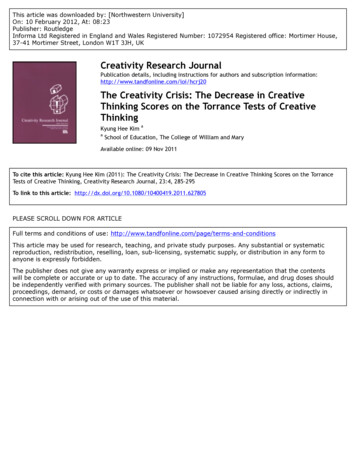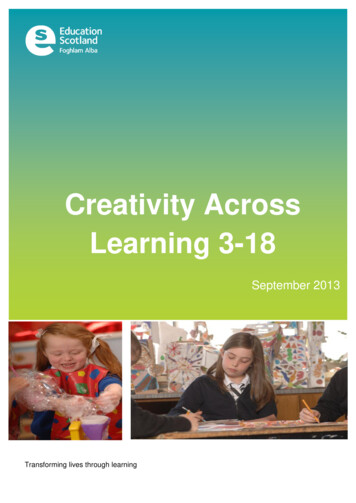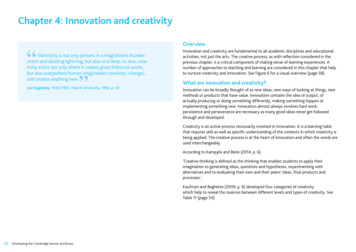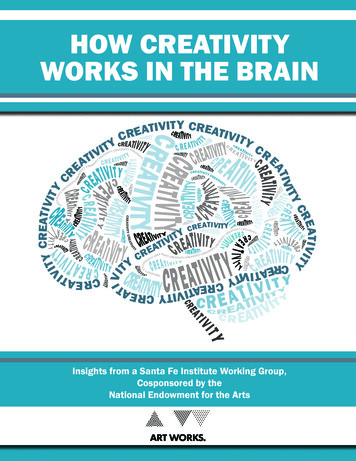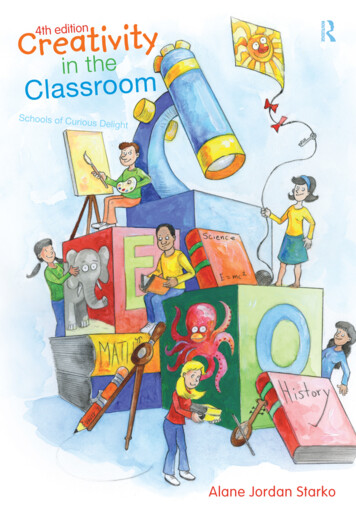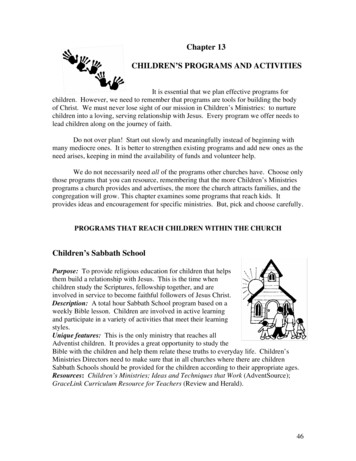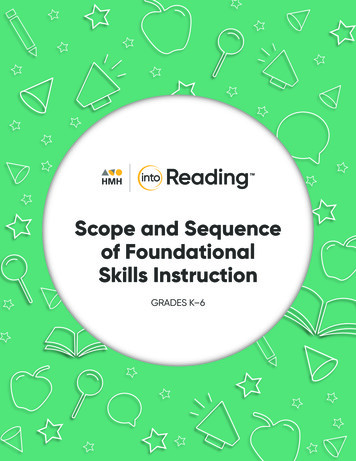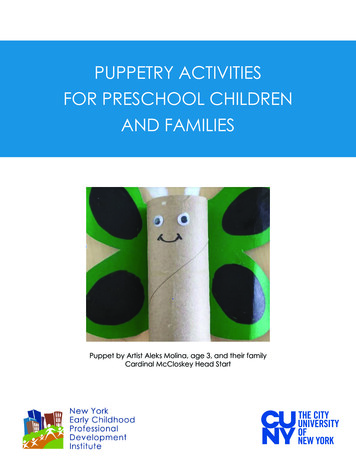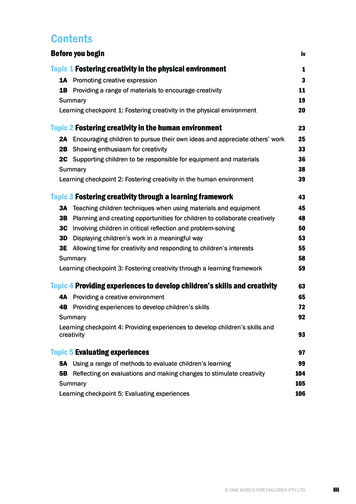
Transcription
ContentsBefore you begin ivTopic 1 Fostering creativity in the physical environment 11A Promoting creative expression 31B Providing a range of materials to encourage creativity 11Summary 19Learning checkpoint 1: Fostering creativity in the physical environment 20Topic 2 Fostering creativity in the human environment 232A Encouraging children to pursue their own ideas and appreciate others’ work 252B Showing enthusiasm for creativity 332C Supporting children to be responsible for equipment and materials 36Summary 38Learning checkpoint 2: Fostering creativity in the human environment 39Topic 3 Fostering creativity through a learning framework 433A Teaching children techniques when using materials and equipment 453B Planning and creating opportunities for children to collaborate creatively 483C Involving children in critical reflection and problem-solving 503D Displaying children’s work in a meaningful way 533E Allowing time for creativity and responding to children’s interests 55Summary 58Learning checkpoint 3: Fostering creativity through a learning framework 59Topic 4 Providing experiences to develop children’s skills and creativity 634A Providing a creative environment 654B Providing experiences to develop children’s skills 72Summary 92Learning checkpoint 4: Providing experiences to develop children’s skills andcreativity 93Topic 5 Evaluating experiences 5A Using a range of methods to evaluate children’s learning 97995B Reflecting on evaluations and making changes to stimulate creativity 104Summary 105Learning checkpoint 5: Evaluating experiences 106iii
Topic 1In this topic you will learnabout:1A Promoting creativeexpression1B Providing a range ofmaterials to encouragecreativityFostering creativityin the physicalenvironmentBy developing an awareness of expressivedevelopment in children, you can plan and provideage-appropriate experiences to support theirindividual creative development.Children tend to express themselves in more creativeways if you plan, set up and provide experiences thatare open-ended, fun and positive.1
CHCECE018 NURTURE CREATIVITY IN CHILDRENSensoryawarenessVisual, auditory, body kinaesthetic (for example, how to moveand shape their body) and tactile experiences (for example,running with bare feet or swirling a scarf)ExplorationTesting physical abilities, choosing movements they are capableof achieving and choosing movements that are new andchallengingProblem-solvingSolving problems such as:Can I fit through this hoop?XX How can I balance this ball?XX How can I reach that?XX How can I use this scarf in dance?XX How can I move fast and slow?XX How do I use this equipment?XXFreedom to explore their body movements and abilities,expressing thoughts and feelings, and interpreting actions intheir own waySocial skillsWorking in groups, communication, self-direction, selfawareness, and recognising and appreciating their own andothers’ uniquenessExampleImaginationand creativityExpressing creativityCallie wants to introduce the children in her group to a range of different movementideas. She accesses some posters of people involved in different cultural dances anda range of music that she can play to match.She displays the posters and plays the music, talking to the children about whichposter might link with this music. The children offer their ideas about the music, thentalk about why each dance might be important to the people in the poster.Following this, Callie asks if dance is important to any of the children. Some talk abouthow they have lessons, and others talk about how they dance at special events.Callie then gives the children an opportunity to dance to the music in ways they feelthe music tells them to dance.DramaChildren have individual ways of expressing theirfeelings. Drama is an excellent method for doing this.By respecting this and encouraging children to beopen in communication and play, children will expressthemselves in various ways. Their expression dependson factors such as:the environment in which they are raisedXX the opportunities given to themXX emotional support and developmentXX their ageXX limits and boundaries set by families and educatorsXX the materials and resources provided to them.XX8 ONE WORLD FOR CHILDREN PTY LTD
1BTopic 1 Fostering creativity in the physical environmentProviding a range of materials toencourage creativityCreativity can be encouraged through the physicalenvironment (materials and resources provided)and the human environment (the social andinteractive component).The environment needs to appeal to children toprovoke their creativity. It needs to empower youngchildren to explore, be curious, investigate, aspire,develop relationships with others and dream ofwhat could be.Plan and present beautiful spaces, open-endedresources, many choices, natural resources andattractive displays.Prompting children to use a range of materialsIf you present experiences in an interesting way, you encourage children to participate.Children are likely to explore more freely as their curiosity takes over and they take theopportunity to choose how to play. You can encourage this by:XX providing an environment that is visually stimulating and attractiveXX setting up creative experiences and displays, including selecting and presenting arange of props and accessoriesXX displaying children’s own creative work along with adult displaysXX modelling your own appreciation of beauty and creativityXX using creativity and representation to record aspects of the programXX considering the use and appealing nature of the indoor and outdoor spaces.Setting up for creative learningWhen setting up an environment, you need to think about how it will encouragecreativity.Tips for encouraging creativity:XXSeparate noisy areas from quiet ones; for example, place block corners away fromeasels, and use shelves, dividers and furniture to separate areas.XXDisplay materials and equipment at the children’s level on open shelves where they cansee and access them, and choose what they would like to use.XXPlace experiences and activities logically in the room; for example, place water playactivities in the wet area outside, and climbing or gross motor activities on carpetedareas.XXArrange tables, chairs and other areas to cater for the number of children you want atthe activity, and ensure seats are at the correct height so that children are comfortable.XXSet up activities according to the space that is available; ensure there are enoughactivities for the children, but do not overcrowd the space.XXEnsure there is enough space for the child to spread out materials, move to create theirdesired work and use their level of skill.11
CHCECE018 NURTURE CREATIVITY IN CHILDRENThe focus should be on using muscles and discovering how things feel. Toddlersenjoy sensory and messy play experiences, such as play dough, clay, slime and fingerpainting. They need some guidance in art activities, as they will often experiment onwalls, doors and other surfaces. This generally occurs because they are unaware of therules of drawing and wish to explore the medium.Older toddlers are able to begin to experiment with scissors and glue. These childrenrequire supervision as they learn to use these tools safely.Creative play for preschoolersPreschoolers have greater muscle control than toddlers.They enjoy the same creative materials, but are able touse them in more complex ways. By four or five yearsof age, some children are able to draw recognisableobjects, although many details may be missing. By sixyears old, most children are interested in discussingtheir pictures.Introduce a wider range of colours and a variety ofmaterials and ways to use them. Always allow childrenof this age to explore new materials in a simple experience before offering them in amore complex way. Ask children what materials they want to use, as they are now ableto make choices and decisions.Creative play for school-age childrenSchool-age children are able to use their imaginations competently. They have theirown ideas of what they think is creative and visually stimulating. School-age childrenhave also developed their own interests and can independently make their owndecisions in play.Art materials and resources are used in a more constructive manner and olderchildren are able to use their imaginations to visualise the type of product or artworkthey would like to create. They have longer concentration spans than younger children,which allows them to sit and complete an activity of interest to them. They also havegood muscle control, allowing them to experiment with a range of materials, resourcesand techniques.When selecting materials for creative play, consider developmental safety and the levelof learning, as outlined in the following table.Developmentalstage14Appropriate materials and activitiesInfantXXA selection of toys valued for their textures, colours and sizesXX Large toys that cannot be swallowedXX Toys that have no sharp edgesXX Toys that are easily washed and cleanedXX Different types of experiences; for example, water play, sandplay and outdoor playToddlerXXIndoor and outdoor activities running together or at differenttimes of the dayXX Activities that reflect an interest in the world and a desire toexplore it with the different sensesXX Experiences that reflect mastery of the child’s own body ONE WORLD FOR CHILDREN PTY LTD
Topic 2In this topic you will learnabout:Fostering creativity in thehuman environment2A Encouraging children topursue their own ideasand appreciate others’workChildren learn to express their feelings and thoughtsthrough self-expression and social interactions. Theyfind out that everyone has their own ideas, feelings andopinions.2B Showing enthusiasm forcreativityBy encouraging children to foster their creativity,educators help children develop as individuals, reflecton their abilities and respect other people’s efforts.2C Supporting childrento be responsiblefor equipment andmaterials23
Topic 2 Fostering creativity in the human environmentEncouraging original ideasWhen children come up with their own ideas for an activity they are usually morecommitted to it as it will relate to their interests at the time.Sometimes children come up with their own ideas, interpretations and expressionsspontaneously; at other times, you may help spark these ideas. Use your oralcommunication skills to encourage children and give them confidence.Steps to encourage children to pursue their ideas:XXAllow them to do whatever they feel like with the materials and situation youprovide.XXGive children sufficient time to work out their ideas. Never hurry them; let themknow they can leave their work and come back to it later.XXDon’t judge their efforts, as this is likely to stifle their creativity.XXSupport them to think of new ideas by prompting them or asking them questions.XXEnsure safety is always a consideration.Encourage children to work through their own ideas while providing support,encouragement and the required resources. You may need to assist children to workout what they need and how they will use materials. However, you should stand back toallow them to develop their own play and think carefully about what they are doing.This helps children to develop a range of skills, including:XX problem-solvingXX persistenceXX peer scaffoldingXX sharing thoughts, knowledge and information with othersXX positive emotional and social competenciesXX confidence.Watch this video about encouraging children to develop problemsolving skills.v 0059Being creative is not just about letting children run with an idea; theystill need supervision and direction to ensure they are safe. Childrenmay need your support or require you to complete tasks for them tosuccessfully fulfil their ideas.27
2BTopic 2 Fostering creativity in the human environmentShowing enthusiasm forcreativityWatch this video about considering children’s strengths andlimitations when organising activities.v 0025As an educator, you have a major influence on the ability of childrento express themselves freely and creatively. As well as using therange of strategies discussed in section 2A to encourage children’screativity, you can be a powerful role model in promoting andsupporting creative efforts.Modelling to promote and support creative effortsThe following are ways that educators can act as role models to promote and supportchildren’s creative efforts.Be enthusiastic about creative expressionYou can introduce children to a range of examples of creative expression in art, music,dance and architecture. This shows children how others use their creative energy andimagination. It may provide a stimulus and some ideas they can refer to in their own work.It also shows children that you are interested in and appreciate creativity, and enjoy lookingat how others see their environment.Be open to new ideasBe enthusiastic and open to new ideas and initiatives suggested by the children.Remember that there are always different ways of doing things and different interpretationsof subjects. You may show different paintings of the same scene or object, and talk abouthow the artists have interpreted them differently. This lets children know there are no rightor wrong ways to express ideas.Show enthusiasm for creative activitiesShow enthusiasm for creative activities such as art, dramatic play, dance and music. Join inthese activities, as children love it when an educator becomes a character or dances to themusic. Read stories with energy and enjoyment, and involve children by asking, ‘What mighthappen next?’ and other questions to sustain their interest. Being an active participantoffers valuable role-modelling and can encourage shyer children to participate.Provide a comfortable environmentFoster an environment that is non-threatening in which children feel safe, relaxed andcomfortable to express themselves without fear of failure, being laughed at or feeling silly.Let them know that all their efforts are valuable, but provide guidance and support whenappropriate without dampening their enthusiasm or self-esteem.Show interest in other culturesBe familiar with how other cultures celebrate creativity and introduce some examples toyour group, such as cooking, music and art. Invite skilled practitioners in your community todemonstrate various cultural activities; for example, Indonesian shadow puppets, Japanesecooking, Aboriginal music or Maori art.33
Topic 3 Fostering creativity through a learning frameworkThe problems children face during creative work are often unlike other problems, suchas how to solve a puzzle or where they will sit at a busy group time. When childrensolve problems, their creative work may take new directions depending on how theirproblems are resolved. For example, if a child is trying to attach two materials togetherand they cannot do so, the work will be altered if they decide to use different materialsor to leave out the attachment.To encourage children to think critically and develop strong problem-solving skills, it isuseful to encourage creative thinking about the situation and to have the child identifyas many resolutions as they can.When children run into problems while completing creative work, encourage them touse their creativity to solve the problems. Doing so helps them to develop stronger:self-esteem and confidenceXX thinking and reasoning skillsXX communication skillsXX knowledge about issues and consequencesXX understanding of emotions.XXIn many situations, your role is to help children find out what the real problem is. Theymay demonstrate frustration and express this in a variety of ways. All educators shouldbe aware of verbal cues and what they may mean, as shown in the following table.What they might say verbally‘I can’t do this.’XX ‘This is too hard.’XX ‘I don’t want to do this.’XX ‘This is stupid.’XX ‘I am stupid.’XX ‘You need to do it for me.’XX ‘I am no good.’XX ‘Why can’t I do it?’XXWhat cues they might giveFrowningXX Growling or making aggressivesoundsXX Stopping workXX Working on the task, but notprogressingXX Asking you to do the taskXX Telling you they can’t do itXX Being aggressive; for example,throwing materials, sweeping theactivity off the table or interruptingothersXXYour task is to help the child move past thesefeelings and help them succeed. Some actions youcan take include:acknowledging their feelingsXX identifying what the issue isXX brainstorming to find solutionsXX selecting the most suitable ideaXX checking back later to ensure all went well.XX51
3ETopic 3 Fostering creativity through a learning frameworkAllowing time for creativity andresponding to children’sinterestsThe EYLF and MTOP both identify that learningoutcomes occur over time. A child’s creativeexpression is influenced by the environment andcontext in which they are undertaking an activity,their current abilities and the time they have towork through their ideas and reflect on their work.Children need time to engage with others, developan experience from a group activity into theirown individual thoughts and ideas, or develop anindividual idea into a group experience. They alsoneed time to practise their skills, and developand reinforce new ones. This is part of an ongoingcycle.Giving children sufficient time to express themselvesCreativity does not always come at appropriate times. For example, a child maycome up with an excellent idea when you are winding up a project or just beginninga discussion session. You may want to move to a meal or snack time, get children tosleep or prepare to go home.While you may need to continue with the day’s program, use your child-centredpractice to demonstrate the importance of children’s creativity. You may simply extendthe time allowed so that the creative activity can be completed. Alternatively, youcould:take a photo of where the children are up to if the situation can be created again tomatchXX put up a ‘Please leave alone’ or ‘Work in progress’ sign so that others know it mustnot be packed upXX take notes or record information so that the ideas are rememberedXX explain when there will be more time and remember to follow throughXX ask the children how they would like to arrange their situation.XXYou may need to inform cleaners and/or other educators to enable some creativeideas to be built upon over days or weeks. This may mean that children takeresponsibility for some part of the service or curriculum requirements, such as:helping to clean around the area using their own brooms and mops, so that thespace is still cleanXX moving other equipment so there is space available for beds/mattresses at sleep/rest timesXX packing other activities away so there is space for meal times or snacksXX moving the activity to a place out of the wayXX creating a sign, note or letter that indicates that the work is in progressXX taking drawings and pictures so that they can rebuild or create it at a later time.XX55
CHCECE018 NURTURE CREATIVITY IN CHILDREN3. Explain what you would do if a small group of children want to build a cubby housefrom food boxes in an area that is currently being used for block building. Thechildren will take three days to build the cubby, which they would then like to usefor dramatic play.Summary58XXIt is essential that children are taught how to use materials and equipmentcorrectly and safely. You have a responsibility and duty of care to provide advice,and show children the most effective way to use materials and equipment.XXWhen children collaborate creatively, they are working together using individualideas, sharing these ideas and coming up with solutions that all are happy toparticipate in.XXSeek out opportunities for collaboration, such as: encouraging small group experiences asking for children’s help working in pairs during group activities developing whole group projects.XXCritical reflection is a skill used to examine something from different perspectives.XXEncourage children to think critically and develop strong skills in problem-solvingwhen faced with a difficult situation.XXDisplay children’s work with their permission thoughtfully and respectfully so theyfeel their work is valued.XXRespond to children’s interests as they arise if it is appropriate.XXBe flexible with your timetable to allow children’s creativity and interests to developand be pursued over a period of time. ONE WORLD FOR CHILDREN PTY LTD
Topic 4 Providing experiences to develop children’s skills and creativity4AProviding a creative environmentCreative and aesthetically pleasing experiencesare an essential part of a service’s curriculumand should be offered throughout the day in bothindoor and outdoor experiences. By working inareas separate from other types of play, childrenhave the opportunity to concentrate on theircreative ideas.Children may also come up with their own ideasand turn experiences chosen by you into creativeactivities. When this occurs, your role is to supportthe change or evolution and provide assistance,materials, resources and space as required.Providing a creative environmentTo effectively nurture children’s creativity, you need to be familiar with the NQS, theEYLF and the MTOP, and how they support your creative curriculum, as outlined in thefollowing tables.NQSReferenceHow it guides your actionsExperiences provided forchildren should includethose that engage children inexploring arts.XX Children should beencouraged and supportedto develop agency throughinvestigating their own ideas.Element 1.1.1Curriculum decision-makingcontributes to each child’slearning and developmentoutcomes in relation to theiridentity, connection withcommunity, wellbeing, confidenceas learners and effectiveness ascommunicatorsXXElement 1.1.2Each child’s current knowledge,strengths, ideas, culture, abilitiesand interests are the foundation ofthe program.XXYou must focus on what ismeaningful to children nowand on open-ended creativeactivities that promote selfexpression, which are flexibleenough to allow children towork at their own level andpace.XX Children can support eachother to learn.XX Children can explore ideasthrough play and use ofimagination.65
CHCECE018 NURTURE CREATIVITY IN CHILDRENEnsuring the environment is challengingChildren’s emerging abilities need to be supported or scaffolded.To ensure you provide challenging (but not frustrating) experiences,build on skills using scaffolding. Experiences that scaffolddevelopment are naturally challenging, especially if you match themwith the way a child learns.The following table has information about identifying children’semerging skills.What the child maysay‘I want to do this.’XX ‘How do you do this?’XX ‘Why is it like that?’XX ‘What do I do?’XXCues they may giveTrying something youhaven’t noticed themdo beforeXX Watching others dosomethingXXWhat you can doProvide modellingand demonstration.XX Provide technologyand appropriatematerials.XX Inform others so theycan support the child.XX Encourage the child.XX Work with the familyto support learning.XXPractice task 111. Give a brief description of a play space or specific environment at a service.2. Describe the aesthetics of this space.70 ONE WORLD FOR CHILDREN PTY LTDv 0052Watch this video about providing creative environments for children.
Topic 4 Providing experiences to develop children’s skills and creativityYou can find many examples of learning stories in the following resources:Educators’ guide to the early years learning framework for f)XX Educators’ guide to the framework for school age care in Australia oviding a range of experiencesAn educator’s role is to nurture creativity at every opportunity to allow children todevelop their skills and self-expression.Open-ended experiences are valuable as they allow you to easily modify or extend whatyou have planned. They also encourage children to decide what they want to do nextand how they want to use the materials and props you have provided.When planning for open-ended, expressive and creative play, there is no right or wrongway for children to do things. However, each experience must meet the requirementsof the NQS, learning frameworks, legislation, and the organisation’s policies andprocedures.Make sure each experience addresses the following aspects:XXChildren’s individual needs must be addressed.XXEnsure there are no stereotypical or inaccurate materials that project limitedideas of gender roles.XXResources and their content should reflect everyday differences and similarities;for example, dolls reflect different races, non-traditional celebrations are held,and books and photos reflect a broad range of people, abilities and lifestyles.XXInteractions between you and the children must be appropriate and modelpositive actions.Planning a group sessionYou should arrange for children to work on their creative experiences over a period ofsessions, days or weeks to enable them to expand on, develop and adapt their work.For each activity you prepare, include a plan of the equipment and material to beused, the time, proposed outcomes and how you might use opportunities to extendchildren’s ideas as they arise.Planned sessions are valuable to both children and staff as they have a definedstructure and there are minimal waiting periods in which the children may loseconcentration or become distracted.Steps for planning a group session:12Plan a settling activity such as an action song or music to gain the children’sattention and increase their interest.Introduce the topic to explain what the session is about.73
Topic 4 Providing experiences to develop children’s skills and creativityFinger paintingFinger painting is a calming activity where children can explore colour,texture, shapes and lines. For younger children and infants, singlecoloured finger paint allows the child to focus on manipulation and howthey choose to discover the paint. Older children enjoy adding a varietyof textures such as wood shavings, glitter or sand to the paint to furtherextend the experience.Finger painting can be done on large paper, tables or trays. If paper isused, it needs to be large enough so that children are not restricted intheir movements. You can finger paint with water-based paint, sand andwater or cornflour mix.The final work can be used to make cards or wrapping paper, althoughthe creative process of finger painting should be the focus.PrintingObjects or cut-out shapes can be used to print on paper or other types ofmaterials using:XX natural objects such as leaves, rocks and pebblesXX spongesXX clay or doughXX hands and feetXX various recycled and found objects, such as lids, corks and cottonspools.You or your service may have a philosophy and policy regarding the use offood in play or creative activities, so be sure to consider this before usingpotatoes or other food-printing ideas.CollageCollage refers to pasting and gluing. Using various sized materials allowschildren to explore a range of ideas and encourages their manipulativeskills by assisting them to grasp thin, thick, small and large pieces ofmaterials such as paper, cloth and corks, and to use a variety of joiningmaterials.Collages can be set up at the table, on the floor, indoors or outdoors. Toavoid the area looking messy and disorganised, set it up in an invitingmanner. Provide materials in bowls, containers or collage trays that keepeach material separate. This enables children to think about what theywant to use or make without sorting through a mess of pieces. Try not toprovide an overwhelming number of collage materials, but select enoughfor the stage of development and previous experience. Ensure there aresufficient paste pots or sticking implements to allow each child to workat their own pace without waiting for others as waiting dulls the creativeideas of the child and makes the experience less valuable.There are numerous types of materials that can be used in collage, allwith a variety of colours, textures, shapes, purposes and sizes. Theseinclude:corksXX bottle topsXX strawsXX clothXX confettiXX woolXX icy-pole sticksXXyoghurt containersXX cotton reelsXX nettingXX old birthday cardsXX egg cartonsXX ribbonsXX stickersXXmagazine cuttingsXX sequinsXX buttonsXX pipe cleanersXX wood shavingsXX plastic tubing.XX85
Topic 4 Providing experiences to develop children’s skills and creativityLearning checkpoint 4Providing experiences to developchildren’s skills and creativityPart A1. Give an example of how you can use curiosity to encourage creativity in anexperience.2. Explain why educators need to understand the developmental level of the childrenthey are planning activities for.3. Describe four ways that creativity can be nurtured in children through plannedactivities.93
Topic 5Evaluating experiencesIn this topic you will learnabout:An essential part of your role is to observe childrendoing an activity to notice how they are reacting. Thiswill help you identify whether they find the experiencemeaningful, how well the activity is meeting their needsand how the experience may be extended in the future.5A Using a range ofmethods to evaluatechildren’s learning5B Reflecting onevaluations and makingchanges to stimulatecreativityThese actions form part of an evaluation process: anongoing cycle of assessment for learning.97
CHCECE018 NURTURE CREATIVITY IN CHILDRENThe following table maps this topic to the National Quality Standard and both nationallearning frameworks.National Quality Standard Quality Area 1: Educational program and practiceQuality Area 2: Children’s health and safetyQuality Area 3: Physical environmentQuality Area 4: Staffing arrangementsQuality Area 5: Relationships with childrenQuality Area 6: Collaborative partnerships with families and communitiesQuality Area 7: Governance and leadershipEarly Years Learning FrameworkMy Time, Our PlacePrinciples Secure, respectful and recipro
3E Allowing time for creativity and responding to children's interests 55 Summary 58 Learning checkpoint 3: Fostering creativity through a learning framework 59. Topic 4 Providing experiences to develop children's skills and creativity . 63 4A Providing a creative environment 65 4B Providing experiences to develop children's skills 72
